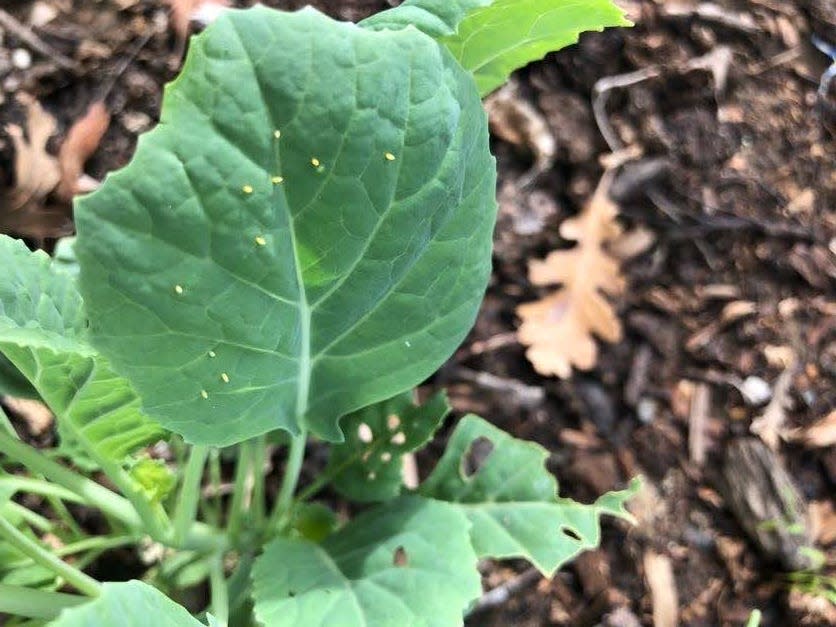The Very Hungry, White Butterfly – and a Beer Challenge

We may have our Eastern Mediterranean neighbors to thank for the multivoltine species, the Pieris rapae cabbage white butterflies in our garden these days. Like the monarch butterfly, the cabbage white produce several generations annually and together complete a migratory route that is an intergenerational roundtrip.
Also commonly known as the “imported cabbage white butterfly”, or “cabbage white”, this butterfly traveled along the trade routes, living in nearby crucifer crops, such as the cabbages, kales, broccoli and bok choy.
Wikipedia sums it up nicely: “Pieris rapae is widespread in Europe and Asia; it is believed to have originated in the Eastern Mediterranean region of Europe, and to have spread across Eurasia thanks to the diversification of brassicaceous crops and the development of human trade routes.
Over the past two centuries, it spread to North Africa, North America, New Zealand and Australia, as a result of accidental introductions.” And according to University of California, Davis Distinguished Professor, Dr. Shapiro, who has been studying butterflies in California for more than 45 years, our only introduced Old World butterfly has made itself at home in our California gardens, flying as often as 44 weeks in the Sacramento-Davis area,” “occurring in disturbed habitats from sea level to about 8000.”
An interesting read on Dr. Shapiro’s website will give you pause as you spot these ubiquitous, yet destructive garden visitors.
Thanks to this year’s perfect fall weather, gardening has commenced and many of us have planted winter veggies, only to discover a slow munch, then a sudden disappearance of plants, thanks to the hungry Pieris rapae cabbageworms.
I recently discovered the “slow munch and quick disappearance” in my young lettuce bed. I was lazy, ignoring the slow munch, thinking, “How much can a few cabbageworms eat?” So I walked on, ignoring the pests. A week later, my lettuce was down to stubs.
My husband, the wiser gardener, had been spraying the broccoli with Bacillus thuringiensis as a preventive method, so I caved and sprayed the lettuce as well, and a week later, the surviving plants looked healthier.
Lessons learned from the UC-Statewide Integrated Pest Management Program (IPM) website and Dr. Shapiro’s very interesting butterfly website made me the wiser, and more educated.
Damage: Check your lettuce and brassica family plants regularly for any sign of cabbageworm damage. “Cabbageworm larvae chew seedlings and large, irregular holes in leaves.” Check under leaves for their tiny eggs.
Management: An ounce of prevention is worth many pounds of veggies — “Closely watch seedlings, which quickly become damaged if the pest becomes abundant. Between thinning or transplanting and heading, cole crops tolerate considerable damage from caterpillars eating leaves. During this time, sample frequently enough to assess numbers accurately and avoid unnecessary insecticide application that can disrupt biological control.” Cultural Control- Cabbageworms survive on hosts in disturbed areas near our gardens. “To prevent imported cabbageworms from migrating into the crop, control cruciferous weeds (such as mustards) that can host them.”
Biological Control: “Where possible, use Bacillus thuringiensis to avoid harming natural enemies. Bacillus thuringiensis is very effective against imported cabbageworm and cabbage looper, especially when applied to early-instar (young) larvae.
Monitoring and Treatment Decisions: “Combine monitoring of imported cabbageworm with monitoring for cabbage looper… Note the time when many adults (butterflies) are fluttering around the field. A few days later, check plants for eggs and small larvae on the underside of leaves. Look for larger caterpillars toward the center of the plant where they often feed near the midrib of leaves. Look for greenish-brown fecal pellets.”
The Dr. Shapiro challenge: “For over 30 years I have offered a pitcher of beer to the person bringing in the first Cabbage White of the year in the Davis-Sacramento area.” “The contest involves collecting the first cabbage white butterfly of the year in the three-county area of Yolo, Sacramento and Solano.
"The traditional rules: Catch a live cabbage white butterfly in the wild in one of those three counties, deliver it live to Shapiro's department in Storer Hall, UC Davis (with the full data, exact time, date and location of the capture) and if it's the first of the year, the winner receives a pitcher of beer or its equivalent.”
Maybe he will consider extending the boundaries to San Joaquin County!
Happy hunting.
Do you have a gardening related question? Contact the San Joaquin UC Master Gardeners at 209- 953-6112. More information can also be found on our website ucanr.edu/sjmg.
This article originally appeared on The Record: Cabbage white butterfly is appearing in Sacramento gardens

